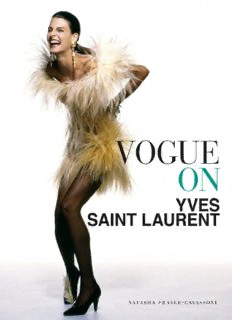
Vogue on Yves Saint Laurent PDF
Preview Vogue on Yves Saint Laurent
Model Carrie Nygren in Rive Gauche’s black double-breasted jacket and mid-calf skirt with long-sleeved white blouse; styled by Grace Coddington, photographed by Guy Bourdin, 1975. Linda Evangelista wears an ostrich-feathered couture slip dress inspired by Saint Laurent’s favourite dancer, Zizi Jeanmaire. Photograph by Patrick Demarchelier, 1987. At home in Marrakech, Yves Saint Laurent models his new ready-to-wear line, Rive Gauche Pour Homme. Photograph by Patrick Lichfield, 1969. DIOR’S DAUPHIN FASHION’S NEW GENIUS A STYLE REVOLUTION THE HOUSE THAT YVES AND PIERRE BUILT A GIANT OF COUTURE Index of Searchable Terms References Picture credits Acknowledgments “CHRISTIAN DIOR TAUGHT ME THE ESSENTIAL NOBILITY OF A COUTURIER’S CRAFT.” YVES SAINT LAURENT DIOR’S DAUPHIN A I n fashion history, Yves Saint Laurent remains the most influential designer of the latter half of the twentieth century. Not only did he modernize women’s closets—most importantly introducing pants as essentials—but his extraordinary eye and technique allowed every shape and size to wear his clothes. “My job is to work for women,” he said. “Not only mannequins, beautiful women, or rich women. But all women.” True, he dressed the swans, as Truman Capote called the rarefied group of glamorous socialites such as Marella Agnelli and Nan Kempner, and the stars, such as Lauren Bacall and Catherine Deneuve, but he also gave tremendous happiness to his unknown clients across the world. Whatever the occasion, there was always a sense of being able to “count on Yves.” It was small wonder that British Vogue often called him “The Saint” because in his 40-year career women felt protected and almost blessed wearing his designs. Although the Paris-based couturier wished that he had invented denim jeans —describing them as “the most spectacular, the most practical, the most relaxed, and nonchalant,” to Vogue’s Gerry Dryansky—he was behind such well-cut staples as the pea coat, the safari jacket, the trench coat, the pant suit, Le Smoking (the female tuxedo), and the introduction of black tights as the chic alternative to pale hosiery. Following in the footsteps of Coco Chanel, Saint Laurent was inspired by black, yet he was a superb colorist who with his bold choice of fabric knew how to brighten an outfit and flatter the complexion. A s a demonstration of Vogue’s attention to promising fashion talent, Saint Laurent had strong links with the magazine from the very start of his career and throughout. It was via Vogue’s Michel de Brunhoff that he met Christian Dior, his first and only boss. It was through the enthusiasm of Vogue’s Diana Vreeland that the American public became instantly sold on Rive Gauche, Saint Laurent’s ready-to-wear line. Meanwhile, Helmut Newton’s iconic Smoking portrait taken in 1975 and other memorable images by the likes of Richard Avedon, David Bailey, Guy Bourdin, and Irving Penn were first viewed within the pages of Vogue. Helmut Newton said Saint Laurent inspired his “best fashion photos.” His mythic portrait of Vibeke Knudsen wearing Le Smoking on the rue Abriot appeared in Vogue Paris in 1975. The pairing of tailored pant suit and soft blouse typified Saint Laurent’s masculine-feminine ambiguity. Naomi Campbell, a frequent Saint Laurent model, photographed by Patrick Demarchelier in 1987 as a haute-couture-clad showgirl—a favorite nighttime look of the couturier’s.
Description: